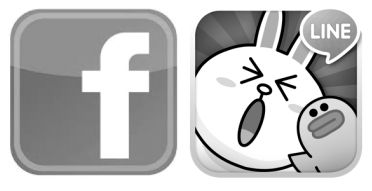This is an article I wrote for the industry journal “Marketing Interactive” in November 2013. Since WhatsApp was recently acquired by Facebook, and now goes head to head with LINE in the chat app race, it is good to be reminded of where LINE has come from, and what makes it so unique and adaptable.
The published article was much whittled down, and although it may be an easier read, it left out several of the more interesting cultural nuances that makes LINE so appealing, as well as its cultural-hybrid origins, so I have belatedly printed my original draft below.
The Marketing Interactive version can be seen here.
On the face of it Facebook have a lot to be smug about when looking at their Japanese footprint.
The original Japanese social network Mixi is in rapid decline, and Facebook now boasts 21m local active monthly users. This has grown rapidly from around four million a couple of years ago, with 86% of users on mobile compared to the global average of 71%. And what’s more Facebook announced in August that it was going to double its Japanese workforce to boost the local advertising business.
All this in a society that many said would never accept a service that does not allow its users to remain anonymous! It just shows how attitudes can change.
Facebook’s user profile is also ideal for many brands, mirroring the demographic bulge of Japan’s population that peaks around the late 30s. The children of the baby boomers are the sweet spot for many brands, and I for one do not see Facebook losing this strength any time soon.
However, exploring the digital landscape a little closer there are some worrying signs for Facebook. Some of which are the same concerns that are levelled everywhere, namely that it never worked out how to monetize mobile, and others which are uniquely Japanese in origin.
Primary among these is the explosive growth of the mobile chat app LINE. Inspired by the wake of the 2011 Tohoku earthquake, or so the story goes, LINE has broken all records on the way to 250 million users globally, 43 million of who are in Japan. Underpinning this meteoric rise has been LINE’s cute UI and simple UX, which reduces to a minimum the number of taps required for all the basic social mobile operations, like adding friends, sharing photos with a selected group etc.
But what makes LINE stand out among the handful of other chat apps currently boasting these kind of user numbers, such as WhatsApp, Viber, and WeChat is its phenomenal ability to monetize its user base.
Unlike Facebook which is now more or less limited to advertising, LINE sells digital goods such as the “stamps” that its users converse with in the chat threads, as well as game credits. And it’s working. In the second quarter of 2013 LINE generated $100m in revenue. That’s one reason it’s a model that is starting to be mimicked by competitors across the globe.
For Japan’s users, who were raised on an image-rich diet of manga characters and anime, the stamps are the easiest and most charming way to express those everyday feelings that friends exchange. In fact they were designed exactly for that purpose, each one mapping to a commonly shared feeling like “I’m exhausted”, or “having fun!”, using 4 original LINE characters as the grammar of this visual language.
Starting with the default set of stamps, users can then buy new stamps for around $1.70 a pop, or else download free stamps from the sponsored gallery, in which brands pay for their own characters to be featured. Many of the stamps that Japanese users buy are manga characters from classic titles they read when they were growing up, so when shared among friends who all know the story and hence the context of the shared frame, the communications exchanged become nuanced with more subtle meaning and personality.
Contrast the layered richness of this communication with the “like” on Facebook, its often baffling privacy settings, and the fact that you have to mind what you post since your boss might have friended you, it is no wonder LINE is where friends prefer to hang out together.
LINE’s growth has so far largely come in East Asia where the same “high context, low content” culture predominates, but what is perhaps surprising is how popular it is proving elsewhere. It has jumped to 10 million users in India in the space of a couple of months having hired a top Bollywood actress as its ambassador, passing 15m users in Spain and is now targeting South America. It is likely to hit 300m users this year and there is talk of an imminent IPO.
Some of us wondered whether Japan, so long a hardware juggernaut and console gaming industry heavy hitter, would ever break its duck in the web services arena. In hindsight it makes total sense that it would take a mobile app with a uniquely visual UX that can be personalized to reflect the visual culture of its users, wherever they are, to have universal appeal.
Although made for Japan, it is an offshoot of a Korean company, NAVER, that realised they had already lost their home market to the chat app Kakao, and so targeted Japan, the closest next market, with a copycat that became LINE. Although late to the party, it is interesting that it is LINE that is now challenging the world, while Kakao is hardly in the running at a global level.
It is possible that by having to adapt the Korea-originated smart phone chat experience for Japan, a market that is similar but not identical to Korea in terms of mobile culture, gave LINE enough cultural flexibility to then make the jump to other markets, including beyond Asia. It almost certainly helped in terms of baking a cross cultural mindset into the culture of the company.
As smart phone adoption continues to grow exponentially around the world it is easy to imagine how a native app built around the universal appeal of emotive images, monetized through digital goods will continue to have Facebook’s sushi lunch from Tokyo to the ends of the earth.


Leave a comment